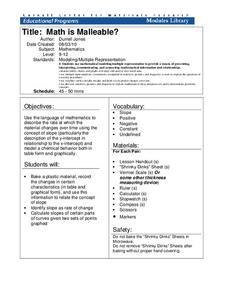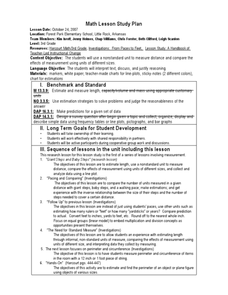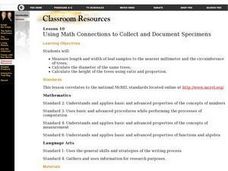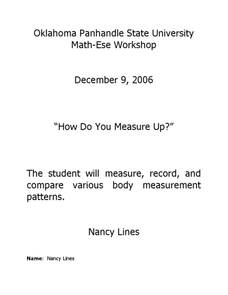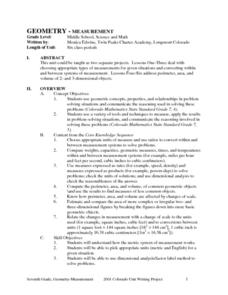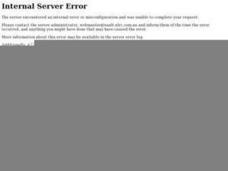Cornell University
Math Is Malleable?
Learn about polymers while playing with shrinky dinks. Young scholars create a shrinky dink design, bake it, and then record the area, volume, and thickness over time. They model the data using a graph and highlight the key features of...
Curated OER
Teddy Bears and Friends
Children begin by making direct comparisons between objects and putting a number of objects into order according to length. They are also introduced to measuring with multi-link cubes which allows them to compare objects which cannot be...
Curated OER
Acute Triangles
Learners study acute triangles. They measure angles using a protractor, then classify the triangles as either right, obtuse, or acute. Everyone creates a design for a Navajo rug using only acute triangles.
Curated OER
Who's On First?
Have you ever considered why the number 10 is so important to us? That's what learners do here. They explore patterns formed by powers of ten and by decimals, convert units of measure within the metric system, and express these in the...
PBS
Surface Area and Volume
You and your class will like this lesson on using visual models to relate the volume and surface area of solid shapes. Learners construct three-dimensional forms using nets. They calculate the surface area and volume for each and then...
Curated OER
Mother May I?
Third graders measure distance using nonstandard units of measure. In this measurement lesson, 3rd graders measure a given distance through the use of the game "Mother May I?" Student gather and compare data on how many "giant steps" and...
Curated OER
Bearly There
First graders read "How Long Is A Foot?" together and use paper clips, teddy bears, crayons and other non-standard units to measure items. They compare the items measured and order them from longest to shortest.
Curated OER
Triangle's Interior Angles
Given a pair of parallel lines and a triangle in between, geometers prove that the sum of the interior angles is 180 degrees. This quick quest can be used as a pop quiz or exit ticket for your geometry class.
Curated OER
A Rectangle in the Coordinate Plane
A quadrilateral is drawn on the coordinate plane, and eighth grade geometers find the length of each side and the diagonals by applying the Pythagorean theorem.
Curated OER
Using Math Concepts to Collect and Document Specimens
Students determine the length and width of leaf samples to the nearest millimeter and the circumference of trees. They participate in a discussion about the importance of collecting specimens carefully. They compile accurate...
Curated OER
Light Plants and Dark Plants, Wet Plants and Dry Ones
Learners plant sunflower seeds in plastic cups, and once germinated, these are exposed to different conditions of light levels and/or soil moisture contents. Students measure growth of the seedlings every few days using non-standard...
Curated OER
Let's Measure
Students discuss comparing the size of two different sets of blocks. They estimate the length of the long blocks by answering the following questions: How can you use the small blocks to find out?, and How many small blocks does it...
Curated OER
ALASKA-CANADA HIGHWAY PROBLEM
High schoolers create a table of ordered pairs, using variables (dependent and independent), writing equations, converting metric and standard measurements for distance using mileposts.
Curated OER
Frequency Distributions and Measures of Central Tendency
Twelfth graders use the Internet to research information on NFL players and construct frequency distributions from the data. They calculate the mean, medium and analyze their data.
Curated OER
Calendar Math
Pupils count and name the numbers and days on the calendar in order to determine the date. They identify the month and the entire date, and determine the pattern shown on the calendar markers. Students then calculate how many days they...
Curated OER
How Do You Measure Up?
Students explore the concept of measurement, modelling the increments on a standard ruler using cubes and grid paper. They identify the length of a line to a designated standard unit and measure specified body parts.
Curated OER
Addendum to the Written Curriculum: Measuring Solids
Learners use standard rulers to measure the length of common classroom items - such as pencils, books, desk tops - in inches and centimeters, and measure weight in pounds. They also answer math questions, such as "How long is the front...
Curated OER
Geometry - Measurement
Students review the procedure for determining appropriate types of measurements for given situations and measurement conversions. They figure perimeter, area, and volume of 2 and 3 dimensional objects.
Curated OER
Measurement
First graders participate in various activities dealing with measurement, length, volume, and temperature. They identify the need for standard units of measure, sort and classify objects, measure distances, and use a thermometer.
Curated OER
Measures of Spread
Students explore the concept of measures of spread. In this measures of spread lesson, students calculate the standard deviation for a set of data. Students use the standard deviation to analyze and describe the set of data. Students...
Curated OER
Measurements in Quilting
Student measure the length of the sides of rectangles and squares using inches, feet and yards. They determine perimeters of rectangles and squares. They then determine areas of rectangles and squares.
Student compare measurement of...
Curated OER
Standard Envelope Sizes
Pupils measure the length and width of various sizes of envelopes. After comparing the envelopes, they explore the ratios, percentages, and rates. Students discuss postal rates and compare the cost of mailing items, delivery times, and...
Curated OER
Angle Attributes and Measures
Seventh graders explore the concept of angles. In this angles lesson, 7th graders use protractors to measure angles. Students sing an angle song. Students discuss attributes of angles using a two-color plate manipulative.
Curated OER
Math: Finding Surface Area
Eighth graders engage in hands-on activities to determine the surface areas of various objects. Using boxes, they cut them so they can lay flat and measure all the various shapes, which can be calculated and added together to equal the...
